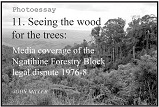Seeing the wood for the trees: Media coverage of the Ngatihine Forestry Block legal dispute 1976-8
Abstract
The first Nga Tamatoa protest at Waitangi in 1971 launched a new era of assertiveness in the struggle for Māori Treaty, land, and cultural rights. Such events as the Māori Land March (1975) and the occupations at Bastion Point and Raglan (1978) received prominent treatment in mainstream media of the day. However, how well equipped were the then predominantly monocultural news organisations to understand underlying issues behind such protests? Four decades on, media commentators have observed the propensity of majority culture media structures to frame their treatment of such events through their own cultural constructs and ignore crucial social, cultural and historical factors that ought inform a more thorough and relevant coverage of such minority culture issues. Although not achieving the same degree of prominence in the media as these other cases, the Ngatihine Land/Forestry legal dispute in Northland, New Zealand, in 1976-8 exposed the inabilities of the media at that time to adequately see past cultural ‘blind spots’ (Morgan, 2009) and take into account important historical and sociological factors in their reportage on this issue. This was something that non-mainstream media were more comfortable with doing. This article examines how the participants in this struggle had to first discover this necessity themselves and then present these frameworks to the media in order to encourage them to produce a more relevant coverage of this land dispute.
Downloads
Metrics

Copyright (c) 2011 John Miller

This work is licensed under a Creative Commons Attribution-NonCommercial 4.0 International License.















